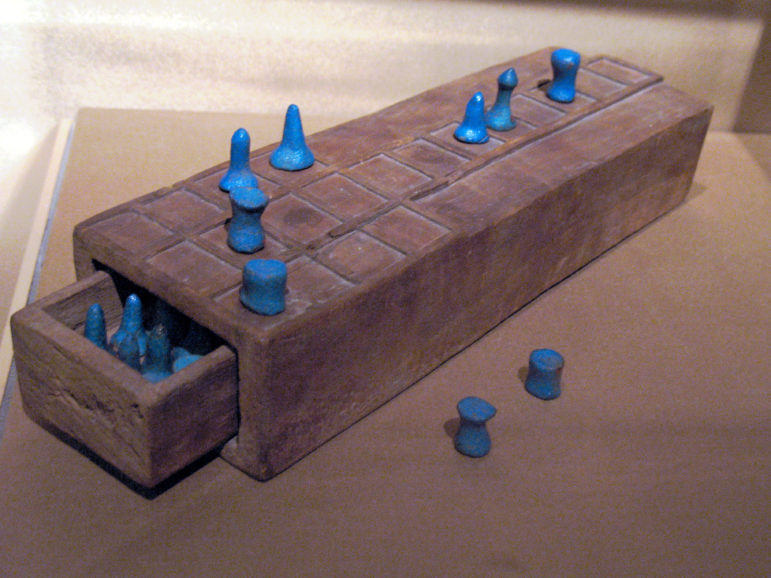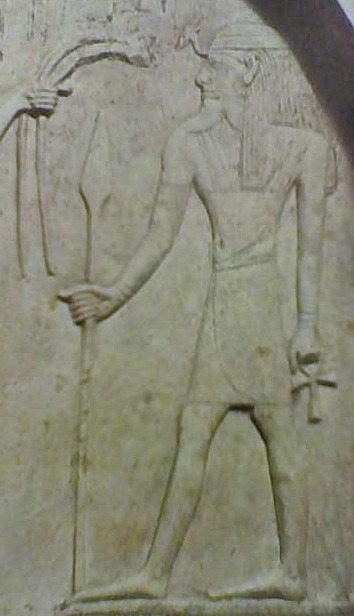Many Pagans draw from ancient religions. They often rely on the work of historians and archaeologists. In “Uncovering the Past,” The Wild Hunt recaps recent archaeological work that Pagans may find interesting.
Ancient board game model for the journey in the afterlife.
SAN JOSE, Calif. – The Website Live Science.com reported about an ancient Egyptian board game called Senet. It began as a leisure activity, but over time became a model for the journey in the afterlife.
Something similar happened with tarot. While the exact history of the tarot is somewhat murky, the early tarot decks were used for card games, and those games are still played in some parts of the world. The modern tarot deck is used by many Pagans for divination and spiritual self-awareness. Some Techno-Pagans have even used computer games as spiritual tools.

Senet Game Board and Playing Pieces – Image credit: JMCC1 – CC BY 3.0
The first historical mention of senet dates from the 1st Dynasty of Egypt, 3100 to 2900 B.C.E. It may be the oldest board game in the world. Egyptian trade spread the game to Egypt’s trading partners in Cyprus, Byblos, and Arad.
The board has 30 squares laid out in a three by ten rectangle. Sources differ on how many squares have inscriptions. Some sources report that four squares had inscriptions. Square 26 signified “Goodness,” square 27 “water,” square 28 the number “three,” and square 29 the number “two.” Other sources report that, besides those four squares, square 15 signified “rebirth.” Players moved pieces across the board based on throwing down a set of sticks. The rules of the game have failed to survive the centuries.
Beginning with the New Kingdom, 1550 B.C.E., Senet became linked with death and the afterlife. Senet functions as a talisman of the “Ka,” the soul or life essence, in the afterlife. For this reason, mourners would place senet boards in tombs. The tomb of King Tut had four senet boards. According to the Egyptian Book of the Dead, the dead would play senet without a partner, like solitaire.
Archaeologists have begun to examine artifacts in the Rosicrucian Egyptian Museum in San Jose, California. In that museum, they discovered a previously unknown senet board. The museum had obtained it from an aristocrat without knowledge of how that aristocrat obtained the senet board.
No radiocarbon tests have determined the age of the senet board from the museum. Instead, archaeologists have dated it on the basis of style. The styles of senet boards changed from the Old Kingdom (2686–2181 B.C.E.), the Middle Kingdom (2055 to 1710 B.C.E), and the New Kingdom (1550–1069 B.C.E.). The senet board of the San Jose museum had the design of senet boards of the Middle Kingdom. It, however, had the decorative aspects of those of the New Kingdom. Its markings resemble those of senet boards from the time of Queen Hatshepsut, 1478 to 1458 B.C.E.
First Canaanite temple in 50 years found
TEL LACHISH NATIONAL Park, Israel – Live Science reported the discovery of a Canaanite temple. They found this temple in the ancient Canaanite city of Lachish. In Canaan, only Jerusalem outranked Lachish.
Ancient Canaan consisted of present-day Israel, the Occupied Territories, Jordan, Lebanon, and southern Syria. The Canaanites built this temple in the 12th century. At that time, Egypt ruled Canaan.
Like other Canaanite temples, the Temple at Lachish had a central space. In that central space were unhewn “standing stones.” Other found artifacts include pottery, bronze cauldrons, daggers, axes, arrowheads, and jewelry.
Excavators found figurines of the gods Baal and Resheph in the inner sanctum of the Temple. Baal ruled over storms. He had a strong antipathy towards snakes. The Phoenicians brought the cult of Baal with them when they founded Carthage. Baal’s cult continued in Carthage. There, Baal took the form of a ram.

Resheph. [Image Credit: Camocon CCO 1.0]”1
Resheph ruled war and plague. The Eighteenth Dynasty of Egypt incorporated Resheph into the Egyptian pantheon. In that pantheon, he became associated with horses and chariots. His worship extended into Egypt during the 18th dynasty.
Recycled Egyptian temple material
ATILT, Israel – The Daily Mail reported that a swimmer discovered a stone Egyptian anchor from 1300 B.C.E. Unusual for an anchor, inscriptions covered its surface. They consisted of hieroglyphics and an image of a woman writing at a table. That image denotes Seshat, the Egyptian goddess of writing. Someone had chiseled away her face away. Archaeologists believe that the stone originally formed part of a temple. Chiseling away her face would secularize the stone.

Seshat [Image Credit: JMCC1 / CC BY-SA 2.0 ]
In Pharaonic religion, Seshat had the role of being the goddess of wisdom, knowledge, and writing. Heliopolis was her main sanctuary. She had close links with Thoth, another god of writing. At various times, texts describe Seshat as his daughter, at others as his wife.
The Archaeological Institute of America publishes the magazine Archaeology and has videos, podcasts, and access to the magazine. The Archaeological Institutes of America also links to on-going interactive digs.
The Wild Hunt is not responsible for links to external content.
To join a conversation on this post:
Visit our The Wild Hunt subreddit! Point your favorite browser to https://www.reddit.com/r/The_Wild_Hunt_News/, then click “JOIN”. Make sure to click the bell, too, to be notified of new articles posted to our subreddit.
